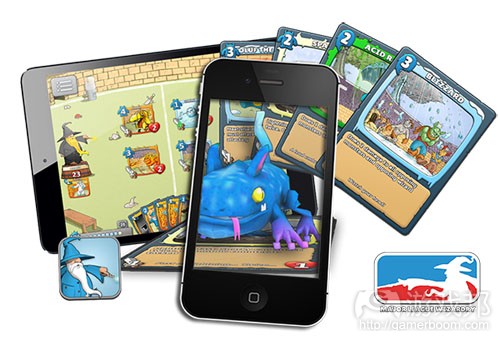探索将实体商品引进手机游戏的操作模式
作者:Zoya Street
电子游戏真的很棒。当我在玩游戏的时候它们总是能够调动我的情绪并创造出一些愉悦的声音。它们会传达给我有趣的故事,并让我觉得是自己促成了这些故事。它们会开启一些对话,并占据着我的生活的大多数时间。然后它们会悄悄地从我的生活中消失,只留给我银行账单上的一个条目以及Steam上的一列道具。
一部分公司正着眼于如何将游戏的刺激感与实体对象的触感联系在一起。我们很容易认为这一开发是像3D印刷等技术的结果,但有时候这与在适当的时候使用参数给予任何一些合适的优惠券更有关系。
《巫术大联盟》便尝试着做出突破,这是来自哥本哈根的一款纸牌游戏。尽管仍处于最初阶段,它却进入了GMIC(上周于旧金山举办的)的Global Game Stars大赛的决赛。这是面向在校生的一款多人纸牌战斗类手机游戏,并带有创新内容:你可以通过与修饰纸牌拍照而升级你的纸牌。这一简单的行动致力于将游戏带出虚拟空间并带向操场,这对于Facebook来说是一种全新的用户获取渠道。
实体纸牌让游戏的合作性变得更强,让玩家可以为了完善自己的虚拟桥牌而与好友间互借纸牌。纸牌本身也具有免费策略:玩家可以在家免费印刷纸牌,但也能够预定高级桥牌并直接送到家门口。开发者David Reeckmann告诉我,他们希望这么做能让家长更放心地购买,因为他们将能够收到实际性的商品。
《巫术大联盟》的成功取决于许多“如果”。如果游戏可以走进校园,如果玩家足够关心高级实体纸牌,这便能够证明实体是付费商品的本质属性。不过依然存在着许多问题,如:当你的IAP是短暂的并且可消费的,你将如何创造一个成功的鲸鱼策略?
也许解决方法是将实体商品当成奖励,而不是所购物。总部位于旧金山的Kiip是一家服务供应商,他们将应用与“虚拟成就的真实奖励”整合在一起。他们从手机游戏出发,但之后分裂成其它能够提升玩家用户粘性和消费的应用类别。在关键时刻,用户会因为用户粘性而获得优惠券作为奖励,并能在现实世界中使用这一优惠券。
Kiip给自己的定位是插播广告的替代选择,即开发者将基于CPE通过在自己应用上声称的每个奖励而赚钱。虽然对于开发者的主要吸引力是盈利,但是Kiip也向其品牌合作者承诺将把游戏有趣的卖点带到广告中。尽管电视广告商因为以被动且放松的状态寻找用户而出名,Kiip却采取了其它策略,即寻求能够匹配用户游戏体验的意外时刻。
其目标不只是盈利——尽管Kunaal Arya告诉我开发者使用他们的SDK是希望能够获得10美元的eCPM(游戏邦注:指的是每一千次展示可以获得的广告收入),这足以与主要的手机广告网站相媲美了,Kiip也致力于通过奖励去提升用户粘性。他们一天所发送的奖励优惠券不会超过一次,并引进机会元素去鼓励玩家不断回到游戏中。他们的内部研究发现那些向Kiip索要奖励的用户会花更多时间于游戏中。
我们可以发现一些类似的品牌整合奖励也出现在《myVegas》中——这是最近发行于手机上的一款Facebook游戏。为了争取各种游戏内部货币,包括能够用于现实世界中的拉斯维加斯赌场的“忠诚点数”,玩家将基于各种拉斯维加斯条块主题去转动老虎机游戏。这一业务模式与Kiip所计划的有点不同:游戏是完全通过玩家在应用内部购买“筹码”而盈利,即花费在老虎机的虚拟货币而不是从品牌合作商那边买进。
《myVegas》的核心游戏循环非常简单,所以我们很难理解它为什么会有如此大的吸引力:你只需要按压绿色按键,形状便会出现在屏幕上,玩家不能控制结果。但是游戏战术行动的简单性隐藏了虚拟货币间复杂的交换。从理论上来看,游戏能够永远免费体验,玩家可以将整个假期投入到拉斯维加斯去按压那个绿色按键,但是他们还必须与决定他们能从老虎机上赢得多少筹码的各种障碍做斗争。现在,其10万名玩家已经通过实体奖励兑换了超过1千万的钱了。
《myVegas》的开发者不想要透露过多有关IAP消费的信息,所以我们不清楚他们有关现实世界奖励的承诺是否真正激励用户往游戏中投入更多钱——或者说,有多少用户为了获得高价值的优惠券而被迫花钱。
有关实体奖励的承诺其实很难弄转换成真正的成功。Kiip的竞争者Pocketchange便不再专注于奖励游戏中的行动,相反地他们将自己当成是一种“宇宙虚拟货币”。我们可以发现许多搭建虚拟奖励与实体产品间关系的不同方法,而时间将告诉你怎样的方法才是最牢固的。
(本文为游戏邦/gamerboom.com编译,拒绝任何不保留版权的转载,如需转载请联系:游戏邦)
Who will bring physical goods to mobile games?
By Zoya Street
Video games really are great. They light up and make joyful noises when I do things to them. They tell me interesting stories, and make me feel like I made those stories happen. They start conversations and swallow days of my life at a time. And then they vanish from my life, leaving no footprints but an entry on my bank statement and a list item on Steam.
A handful of companies are looking into how to connect the thrills of gaming with the tactile wonder of physical objects. It’s tempting to see this development as a result of technologies such as 3D printing, but sometimes it has more to do with using metrics to give someone the right coupon at just the right moment. It’s also about curve pricing — physical objects promise great possibilities for the quest to allow people who love what you do to spend lots of money on things they truly value.
One project that is trying to crack that nut is Major League Wizardry (MLW), a card game being developed in Copenhagen. Though still only in alpha stage, the game made it to the finals of the Global Game Stars competition at GMIC last month in San Francisco. It’s a mobile multiplayer card battler for schoolkids, with a twist: you can level up your cards by photographing them side by side with modifier cards. This simple action aims at bringing the game out of virtual space and into the playground, the user-acquisition channel for players too young for Facebook.
Physical cards make the game more cooperative, allowing friends to borrow cards from each other in order to improve their virtual deck. And the cards themselves have a freemium strategy: players can print them at home for free, but they will also be able to order deluxe packs to be delivered to their door. Developer David Reeckmann told me that he hopes this will give parents a greater sense of confidence in their purchases, knowing that they can expect a physical good to arrive in meatspace.
MLW’s success relies on a lot of ‘ifs’. If they can get into schoolyards, and if players care enough about deluxe physical cards, then they might be about to prove that physical is the natural home of premium goods. A lot of question marks remain, however: for example, how do you build a successful whale strategy when your IAPs are not ephemeral and consumable?
Perhaps the solution is to treat physical goods as rewards, rather than purchases. San Francisco-based company Kiip is a service provider that integrates apps with ‘real rewards for virtual achievements’. They began in mobile gaming, but have branched out into other app categories that have been struggling to motivate the same levels of player engagement and spending. At key moments, users are ‘rewarded’ for their engagement with the app with a coupon to redeem in the real world.
Kiip position themselves as an alternative to interstitial ads, with developers making money on a CPE basis for every reward claimed in their app. While developers are drawn primarily to the monetisation side, Kiip promises its brand partners a way to bring the joyful bells and whistles of gaming to advertising. While TV advertisers have a reputation for seeking users in a passive, relaxed state, Kiip takes the other tack, seeking out ‘moments’ of serendipity that match a user’s game experience to the brand’s desired message.
The goal isn’t just monetisation — though Kunaal Arya tells me that developers using their SDK should expect an eCPM of $10, which compares favourably with major mobile ad networks — Kiip also aims to increase engagement through its rewards. Reward coupons are delivered no more than once a day, introducing a chance element that encourages players to keep coming back for multiple sessions. An in-house study found that users who claim Kiip rewards spend 68% more time in-game.
Somewhat similar brand-integration rewards have been integrated into myVegas, a Facebook game that recently launched on mobile. Players spin slot games with various Las Vegas strip-themed designs to earn various in-game currencies, including ‘loyalty points’ which can be redeemed for real-world rewards in actual Las Vegas. The business model is slightly different to that proposed by Kiip: the game is monetised entirely through in-app purchases of ‘chips’, the virtual currency that is spent on the slots themselves, rather than through buy-in from brand partners.
The core gameplay loop of myVegas is so simple that it is hard to understand the appeal: you just press a green button and shapes appear on the screen, and the player has no control over the outcome. But the simplicity of the game’s tactile action conceals a complex exchange between virtual currencies that seems designed to confuse and compel. In theory, the game is free to play forever, and players could fund an entire holiday in Las Vegas just from pressing that green button, but they have to contend with a variable friction curve that determines how many chips they can win from slots alone. At present, its 100,000 players have redeemed over $10 million in physical rewards.
myVegas‘s developer was unwilling to divulge details about the level of IAP spending, so it’s unclear if the promise of real world rewards is motivating users to spend more — or conversely, how much users compelled to pay in order to get at the high-value coupons.
The promise of physical rewards is not easy to turn into success. Kiip’s competitor Pocketchange no longer focuses on rewards for actions in games, and instead sees itself as a ‘universal virtual currency’. There are many different ways to bridge virtual rewards and physical products, and time will tell which bridge is the most stable.(source:gamesbrief)
上一篇:举例阐述手机游戏中的手势设计要求








































 闽公网安备35020302001549号
闽公网安备35020302001549号